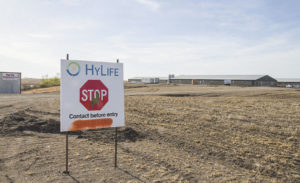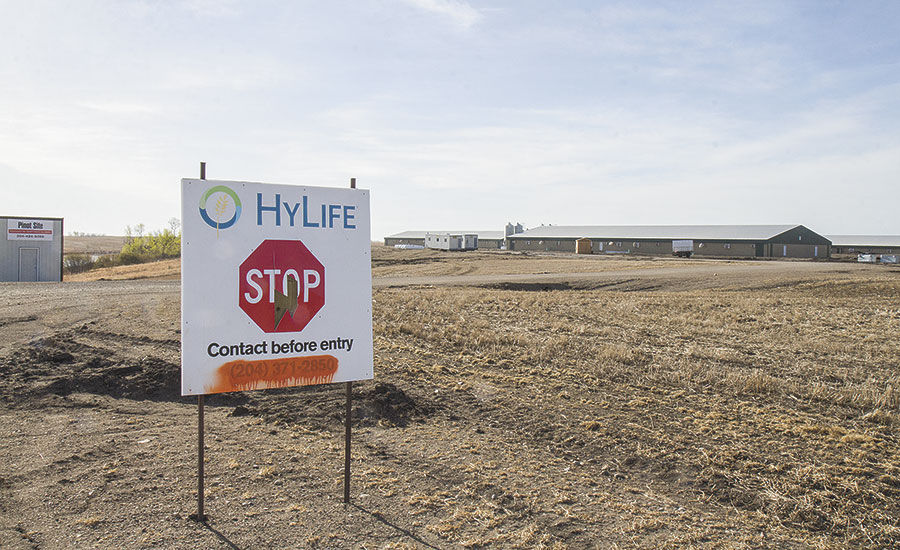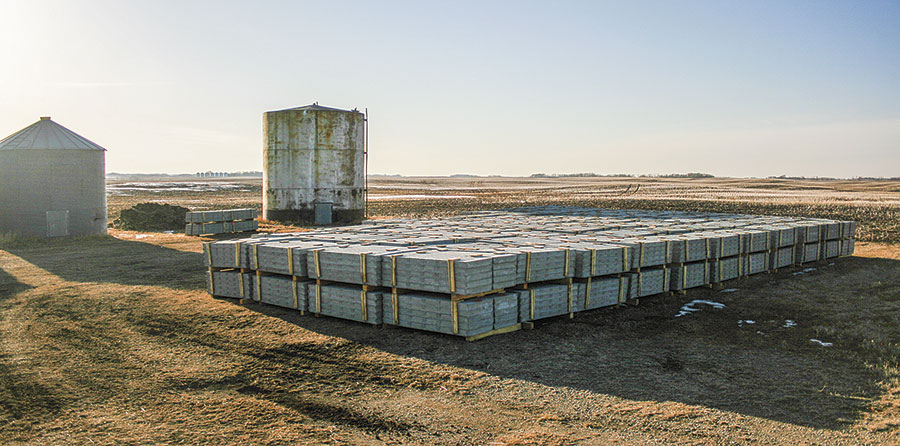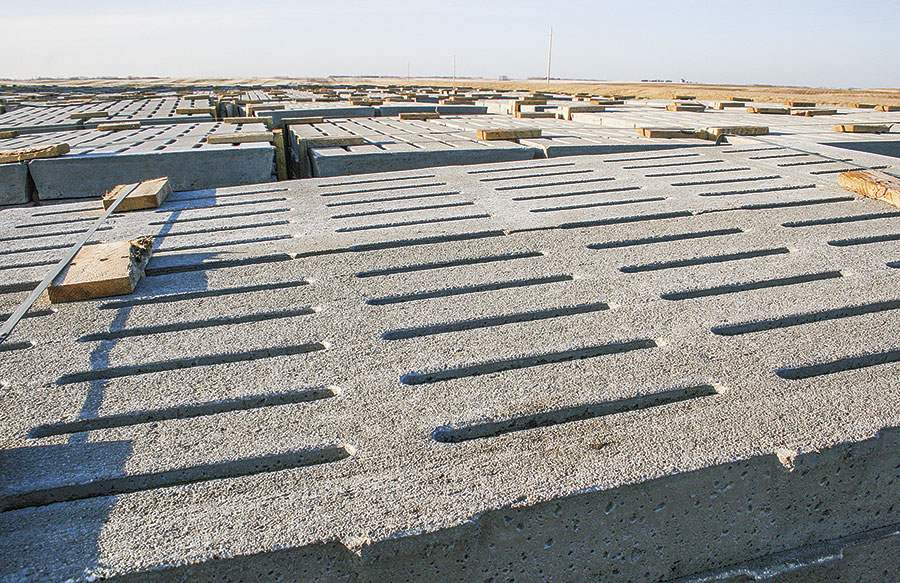
Councillors seeking legal advice on all four HyLife conditional use applications before voting takes place
BY KIM LANGEN
Following a highly concentrated week – which included four consecutive public hearings held on Monday evening and Tuesday morning regarding four separate HyLife hog barn applications – local councillors are facing big decisions before going to the vote.
The complex issue of these proposed hog barn developments has divided much of the community, firing up emotions ranging from fear to fury, and from optimism to dulled resignation.
Rick Pauls, local mayor for the Municipality of Killarney-Turtle Mountain, said the intensity had also affected himself and his six council members: Mike Bellew, Connie Blixhavn, Randy Hodge, Joan Kemp, Ron Opperman, and Janice Smith.
And they still have a mountain of work ahead of them before a decision can be made.
“Council has an awful lot of information to absorb,” said Pauls, following an all-day council meeting held on Wednesday, May 9, the day after the Tuesday hearings. “So many things have changed since 2005 or 2006, when we had our last conditional use application. We had Peter Andersen, the planning guy, here all day. There’s a lot of things going back and forth. No decision has been made at this point.”
In fact, council is now consulting with a lawyer, regarding the legal wording, in general, in regards to all four of the conditional use applications.
“On May 16 we will have another council meeting, and we will go over our legal advice,” said Pauls. “No vote is scheduled, but it could happen.”
So what has led us to this point in time, and what power does the local council hold over the progress of these hog barn applications?
HyLife Ltd., the proponents, said during the Tuesday morning meeting that it had taken them 16 months to reach the point of this week’s public hearings.
Using a large flow chart, or storyboard, they showed the public – which numbered around 70 people seated in the Shamrock Centre Lounge – how all the parties involved participated to move the Napa project forward over these last months.
Don Malinowski, representing the Technical Review Committee (TRC), a team of experts including people trained in agriculture, business development, community planning, highways, and sustainable development, told the room that when they screened all the reports, they looked for “showstoppers,” something that could stop the process.
“The province has no technical issues with this project,” he said.
The Napa site application, located at NE-24-01-18W, involves the building and operation of a 10,000 head-hog finisher operation, consisting of 1430 animal units on the site.
Letters both for and against the proposal were read out by chair of the hearing, Rick Pauls, and a number of people took to the microphone to air their views.
In brief, some of the positive points included: cost savings for farmers (re: hog barn manure spreading vs. fertilizer costs); taxes generated for the municipality; the improvements from modernization of barns for both workers and animals; the use of shelterbelts; and valuable jobs for hog barn workers, and related employees.
Negative points included: concerns with runoff during manure spreading done by contractors, and what recourse existed; the negative effects of odour for a local guide outfitter operation; the absence of an actual existing ‘neighbour’ when it came to hog barns; why the difference of a two-mile buffer zone for Killarney, but only a 300-metre one for hog barn neighbours; concerns for the health of two children with respiratory and heart issues related to muscular dystrophy; loss of quality of life due to hog barn odour; effects of an increased number of heavy trucks on the roads; dust; concerns over potential water contamination; concerns over losses in property value; and whether an inspector would be on hand to monitor the injection of manure on surrounding fields.
The panel of TRC experts, plus a number of HyLife employees and other industry people, who together mostly dominated the two front rows of the meeting, were able to address all the questions posed by both the audience, and by members of the council.
The other three proposed sites, including the Tuscany site, on SE-12-01-18W, for a 10,000 head-hog finisher operation; the Niagara site, on SW-13-01-17W, for a 10,000 head-hog finisher site; and the Southgate Expansion site, on NE-03-01-16W, for development of a 20,000 head-hog finisher operation consisting of 2,860 animal units, were dealt with in a fairly similar fashion.
Throughout the meetings the mood was mostly respectful, somewhat sombre, and sometimes highly emotional.
Proceedings were held firmly in check by Mayor Pauls, who sternly informed people at the beginning of each hearing that “order will be maintained,” speakers must be “concise and respectful,” and that council would notify the concerned parties when their decision was finally made on each of the proposals.
One impromptu outburst of applause following a speaker’s words was quickly suppressed.
One family asked about the possibility of a buy-out by HyLife, so they could move away from the possible encroaching barns. The pork company told them that buy-outs were not currently a HyLife practise.
Mayor Pauls posited the idea of having HyLife help pay for the damage incurred on gravel municipal roads each year, due to increased HyLife truck traffic, which was estimated to be 520-780 extra trucks on the road each year.
These would include some eight to 12 feed trucks per week, and two to three livestock trucks each week, or an average of two heavy vehicles each day.
Were they open to the idea of a development agreement, he asked the HyLife representatives. They were unable to agree without further conferencing at a later time, they said.
And this idea of development agreements is currently on council’s mind, going forward.
It would be one way of recouping some of the costs to the municipality, they said, should development proceed.
Community planner for Manitoba, Peter Andersen, helped on Wednesday to guide council members through the conditions they could impose as part of the conditional use orders.
These matters can include the construction or maintenance, at the owner’s expense, or partly at the owner’s expense, of roads, fencing, landscaping, shelterbelts, or drainage works required to service the livestock operation.
It also includes the choice of coverage on manure lagoons, he added: either straw or synthetic fibre.
In regards to roads, he suggested they work out the general costings, rather than consider a per-truck levy.
“It would be better to use a calculated figure,” he told council.
Later in the meeting, Ken Anderson, public works manager for the municipality, gave council some general advice and early estimations in regards to the roads.
“Most of our roads are 50 to 60 years old,” he said. “And they were designed for a one-ton truck. To build a new gravel road now would maybe be around $120,000 for half a mile. To rebuild a better and stronger one would cost under $100,000 for a half a mile.”
In general, Anderson said it cost around $4,000 per mile just to maintain a gravel road.
These issues, and many more, will help form the final decisions of the mayor and six council members in the coming days or weeks, regarding the four hog barn applications.
A majority vote, which is a minimum of four of these seven, will pass a conditional use order.

HYLIFE PINOT SITE – Pork giant HyLife Ltd. built this modern new barn last year, called Pinot Site, just off Road 93W near Holmfield. The company is now seeking four conditional use orders for four new barns, all to be built south of Killarney, and public hearings were held on the applications on May 7 and 8 at the Shamrock Centre.
New hog barn plans not a slam-dunk
April 20, 2018 edition of The Guide: HyLife is “storing” building materials on one proposed site, pending conditional use permission by municipal council
 CONCRETE TIERS A CONCERN TO NEIGHBOURS – The two tiers of cement materials piled up here at the proposed HyLife Tuscany Site hog finisher barn at SE-12-01-18W had area residents alarmed that no consultation had taken place – and building was imminent. The materials are just being stored with the landowner’s permission, says the Municipality of Killarney-Turtle Mountain.
CONCRETE TIERS A CONCERN TO NEIGHBOURS – The two tiers of cement materials piled up here at the proposed HyLife Tuscany Site hog finisher barn at SE-12-01-18W had area residents alarmed that no consultation had taken place – and building was imminent. The materials are just being stored with the landowner’s permission, says the Municipality of Killarney-Turtle Mountain.
BY KIM LANGEN
When rural residents south of town recently saw hundreds of tons of cement castings piling up on a proposed hog barn site, tempers flared.
Despite a number of highly emotional and powerful letters of opposition sent to the Technical Review committee, and before a hearing on the conditional use application had even taken place, they thought it was game over.
But Rick Pauls, mayor for the Municipality of Killarney-Turtle Mountain, says that the erection of four proposed finisher hog barns – including the one with the stockpiled cement materials – are not a foregone conclusion by any means.
The stockpiling was a shock to them as well, he said.
“Councillors were contacted by members of the public, who saw these building materials being brought in,” said Pauls. “We contacted the province, the Technical Review Committee (TRC), to see if they were in violation, and if they (HyLife) were just assuming a conditional use application would go through,” he said.
Pauls said that it turns out that the landowners of the property in question, on SE-12-01-18W, had in fact given permission to applicants HyLife Ltd. to store items on the site, and therefore HyLife was not in violation of the planning laws.
“They apparently moved materials there before the road weight restrictions go into force,” said Pauls. “If they don’t get conditional use, they will have to move the materials again.”
Residents in the area already live within the vicinity of a number of existing hog barns, all within a few miles of their homes.
The new ones, which would be even closer, would bring still more hog barn odour into their lives, they said.
“This planned operation, known as Niagara, is extremely close – kitty-corner to our property and others,” said Chuck Wilsone, a retiree who moved to the area in 2008 with his wife Kim to escape the hog barn odours near Landmark. “Because it’s so ridiculously close, I don’t believe that prevailing air flow from other directions will stop the smell of this operation on our property. This is not what we planned to live by in retirement.”
Cattle producer and farmer Harry Krahn is worried about both odour and water issues, should new barns go up, some within two miles of his home.
“At my location I would be surrounded by barns,” he said. “With these proposals there would be almost no relief from hog odour, no matter what direction the wind blows from. Another concern would be the amount of water usage by such a large number of hogs, putting pressure on our water supply. I run a cattle operation myself, and water is quite important. But the primary concern is land value, especially for our yard site.”
For Dennis and Jacquie Kowal, the news of the proposals was alarming.
“When we were told of these proposed hog operations, our hearts sank,” they said. “We have a home that we have renovated for our two sons who have muscular dystrophy. These renovations include an elevator, ramps, an accessible bathroom, and have cost us a considerable amount of money over the years. The closest barn to our home would be located approximately half a mile from us. When the pig stink gets so bad, we can’t just pack up and move to town as an option to get away from them.”
Some residents feel that the image of these building materials accumulating on the proposed Tuscany Site is creating a sense of hopelessness and helplessness.
They fear that due process is not being served, and their rural voices are not being heard.
And Pauls agrees.
“I understand what the perception is on this,” he said. “I get how it looks. But these conditional use applications are not a foregone conclusion at all. They (HyLife) did it at their own risk. We knew nothing about it. And we are definitely taking flak over it. Flak for something that has nothing to do with us. It has placed council in a horrible public perception.”
To add fuel to the fire, the public hearing scheduled for residents to voice their opinions earlier this week was postponed at short notice.
It turns out that due to an oversight, council had failed to adequately advertise the Monday evening meetings in their local paper (The Guide) in order to fulfil legal requirements.
Four separate meetings (one for each proposal, at different times) have since been re-scheduled for May 7 and 8.
They will take place upstairs at the Shamrock Centre, in the Elks Lounge, said Pauls.
Only after the hearings have taken place, and councillors have carefully considered the applicant’s information, the public’s response – including the letters (see Letters to the Editor on page 4) – will they vote on the four applications for conditional use orders.
These four applications include one for a 10,000 head hog finisher operation, consisting of 1,430 animal units, on SW-12-01-18W, to be called the Tuscany Site.
The Niagara Site would be located on SW-13-01-17W, and would allow a 10,000 head hog finisher operation, consisting of 1,430 animal units.
On NE-24-01-18W would be the Napa Site, with a 10,000 head hog finisher operation, consisting of 1,430 animal units.
And lastly would be the Southgate Expansion Site, located on NE-03-01-16W, for a 20,000 head-hog finisher operation, consisting of 2,860 animal units.
 CONDITIONAL USE ORDER STILL NEEDED – Here’s a close-up photo of the cement materials trucked in recently to the proposed HyLife Tuscany Site hog finisher barn at SE-12-01-18W. HyLife moved the materials to the site with the landowner’s permission, before road restrictions came into force, say council, who investigated the actions and found them legal. Without a conditional use order, the hog barn cannot be built.
CONDITIONAL USE ORDER STILL NEEDED – Here’s a close-up photo of the cement materials trucked in recently to the proposed HyLife Tuscany Site hog finisher barn at SE-12-01-18W. HyLife moved the materials to the site with the landowner’s permission, before road restrictions came into force, say council, who investigated the actions and found them legal. Without a conditional use order, the hog barn cannot be built.

